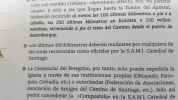The actual route traveled is not as relevant as the distance traveled, in a more or less continuous line from somewhere, INTO Santiago de Compostela. So, you could literally start anywhere that was at least 100 km out from Santiago and be eligible for a Compostela.
The KEY thing is to carefully document that sequential and chronological progression and movement towards Santiago de Compostela with AT LEAST two sellos (rubber stamps) daily. More are better, especially if you are traveling the route or road less traveled.
However, there is NO specific requirement to have walked on any recognized route. This is why the variants on the Portuguese Camino are perfectly acceptable. It is the minimum distance that is critical, not the starting place, per se.
As another example, this May, I hope to do what I am terming the Camino Primitivo "Mixto.' My plan is to start at Oviedo, walk the Primitivo to Lugo then hang a right just beyond the bridge outside of Lugo to follow a "Greenway" hiking path. These are rural paths or roads marked with green arrows. A two days' walk leads on to a left turn, joining the Camino del Norte at Sobrado. From there, I plan to navigate to join the main
Camino Frances route at about Lavacolla. This is the last night before entering Santiago.
The main Primitivo route joins the Frances at Melide, four days out from Santiago. My intention, as was last year taking the Invierno, is to find viable alternatives to dealing with the
Camino Frances, to the extent possible, especially during the main pilgrimage season. As we approach the next Holy Year in 2021, these detours will help reduce overcrowding on the Frances and reduce anxiety for repeat pilgrims.
Hope this helps.






















